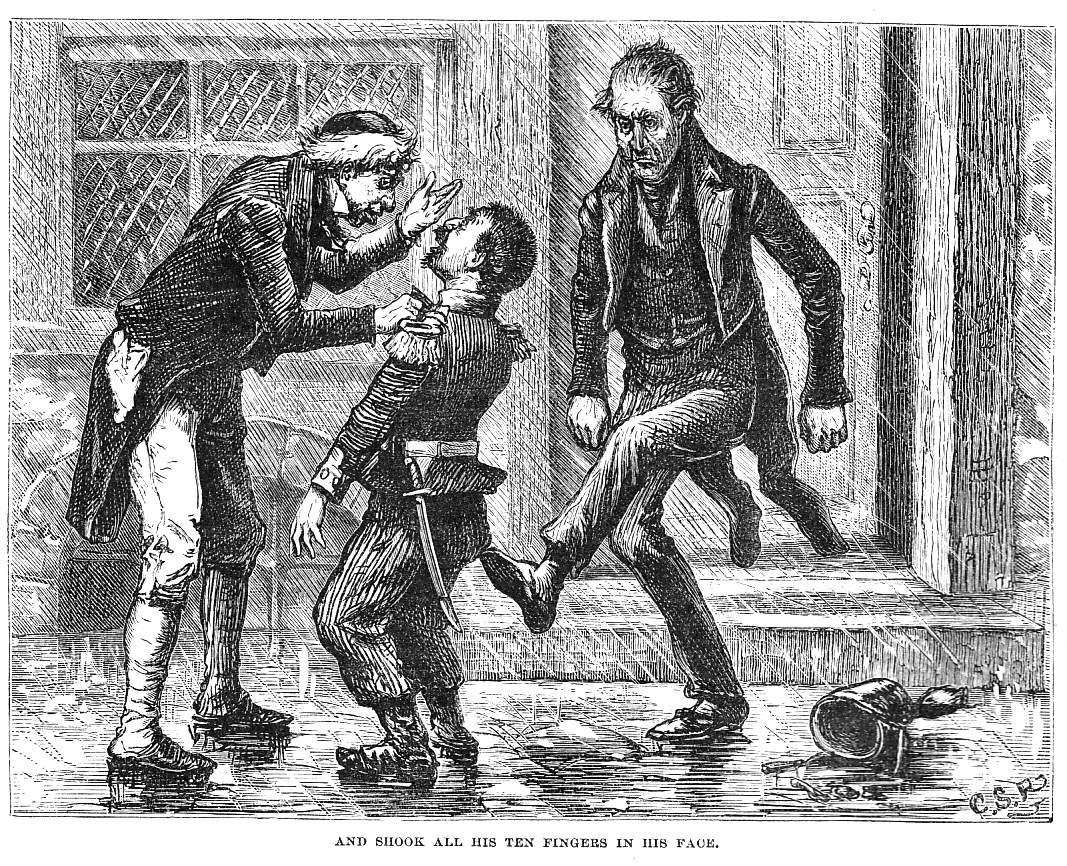
And shook all his ten fingers in his face by Charles S. Reinhart (1844-96). 10.2 cm high by 13.3 cm wide (half-page, horizontally mounted in the middle of 35). [Click on image to enlarge it.]
The wood-engraving illustrates a scene on pages 34-35 in "Travelling Abroad," the seventh chapter in Charles Dickens's The Uncommercial Traveller, this essay having first appeared in All the Year Round on 7 April 1860. The American Household Edition, also containing Reinhart's wood-engravings for Hard Times (1854) and Fildes' for The Mystery of Edwin Drood (1870), was published by Harper and Brothers in 1876.
Passage Illustrated
The dim appearance of a man at Straudenheim's shoulder, inspired me with a misgiving that somebody had come to murder that flourishing merchant for the wealth with which I had handsomely endowed him: the rather, as it was an excited man, lean and long of figure, and evidently stealthy of foot. But, he conferred with Straudenheim instead of doing him a mortal injury, and then they both softly opened the other window of that room — which was immediately over the housekeeper's — and tried to see her by looking down. And my opinion of Straudenheim was much lowered when I saw that eminent citizen spit out of window, clearly with the hope of spitting on the housekeeper.
The unconscious housekeeper fanned herself, tossed her head, and laughed. Though unconscious of Straudenheim, she was conscious of somebody else — of me? — there was nobody else.
After leaning so far out of the window, that I confidently expected to see their heels tilt up, Straudenheim and the lean man drew their heads in and shut the window. Presently, the house door secretly opened, and they slowly and spitefully crept forth into the pouring rain. They were coming over to me (I thought) to demand satisfaction for my looking at the housekeeper, when they plunged into a recess in the architecture under my window and dragged out the puniest of little soldiers, begirt with the most innocent of little swords. The tall glazed head-dress of this warrior, Straudenheim instantly knocked off, and out of it fell two sugar-sticks, and three or four large lumps of sugar.
The warrior made no effort to recover his property or to pick up his shako, but looked with an expression of attention at Straudenheim when he kicked him five times, and also at the lean man when he kicked him five times, and again at Straudenheim when he tore the breast of his (the warrior's) little coat open, and shook all his ten fingers in his face, as if they were ten thousand. When these outrages had been committed, Straudenheim and his man went into the house again and barred the door. A wonderful circumstance was, that the housekeeper who saw it all (and who could have taken six such warriors to her buxom bosom at once), only fanned herself and laughed as she had laughed before, and seemed to have no opinion about it, one way or other. [33-34]
Commentary
Dickens's observant and detached persona, the Uncommercial Traveller, takes a ponderous German coach to the Continent, just as Dickens and his burgeoning family did to Genoa in 1844, in an article published in All the Year Round on 7 April 1860, and subsequently entitled "Travelling Abroad" when published in volume form. However, this traveller is accompanied neither by wife nor by children when he visits Paris and then proceeds to Strasbourg. Here on a wet Sunday evening he attentively watches a real-life "vaudeville" farce unfold in a house opposite his hotel, a house which he takes to be the shop of a jeweller or goldsmith named Straudenheim. The Reinhart scene resembles the same realisation by Edward Dalziel, "The tall glazed head-dress of this warrior Straudenheim instantly knocked off", although Reinhart shows the faces of the little man's persecutors, and captures the precise moment at which Straudenheim's accomplice (right) is in the act of kicking the soldier from behind as Straudenheim shakes his fingers in the little soldier's face. The "shako" is already on the ground in Reinhart's illustration, rather than just flying off the soldier's head, as in Dalziel's. However, the American illustrator provides a stage set more consistent with the shop front that Dickens describes, rendering the scene as more consistent with stage farce.
Scanned image and text by Philip V. Allingham [You may use this image without prior permission for any scholarly or educational purpose as long as you (1) credit the photographer and (2) link your document to this URL in a web document or cite the Victorian Web in a print one.]
Bibliography
Bentley, Nicolas, Michael Slater, and Nina Burgis. The Dickens Index. New York and Oxford: Oxford U. P., 1990.
Dickens, Charles. The Uncommercial Traveller, Hard Times, and The Mystery of Edwin Drood. Il. Charles Stanley Reinhart and Luke Fildes. The Household Edition. New York: Harper and Brothers, 1876.
Dickens, Charles. The Uncommercial Traveller. Il. Edward Dalziel. The Household Edition. London: Chapman and Hall, 1877.
Scenes and Characters from the Works of Charles Dickens; being eight hundred and sixty-six drawings, by Fred Barnard, Hablot Knight Browne (Phiz); J. Mahoney; Charles Green; A. B. Frost; Gordon Thomson; J. McL. Ralston; H. French; E. G. Dalziel; F. A. Fraser, and Sir Luke Fildes; printed from the original woodblocks engraved for "The Household Edition." New York: Chapman and Hall, 1908. Copy in the Robarts Library, University of Toronto.
Slater, Michael, and John Drew, eds. Dickens' Journalism: 'The Uncommercial Traveller' and Other Papers 1859-70. The Dent Uniform Edition of Dickens' Journalism, vol. 4. London: J. M. Dent, 2000.
Created 7 April 2013
Last modified 6 January 2020